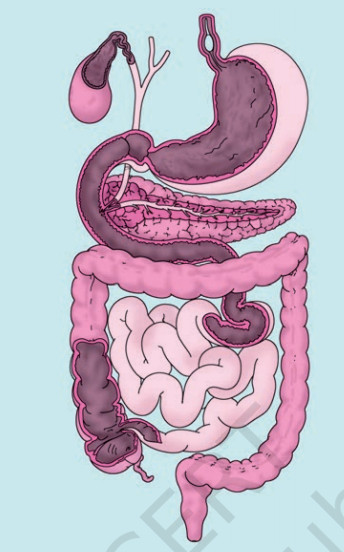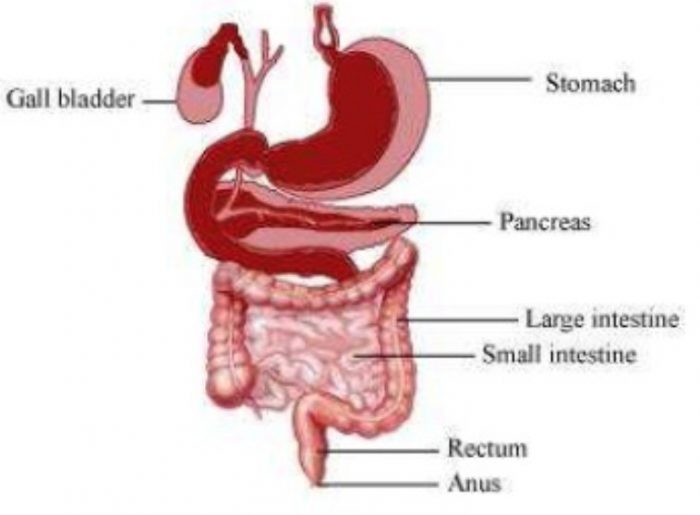NCERT Solutions for Chapter 2 Nutrition In Animals for Class 7
Question 1. Fill in the blanks:
(a) The main steps of nutrition in humans are __________, __________, __________, _________ and __________.
(b) The largest gland in the human body is __________.
(c) The stomach releases hydrochloric acid and ___________ juices which act on food.
(d) The inner wall of the small intestine has many finger-like outgrowths called _________.
(e) Amoeba digests its food in the ____________ .
Answer 1 (a) The main steps of nutrition in humans are ingestion, digestion, absorption, assimilation and egestion.
(b) The largest gland in the human body is liver.
(c) The stomach releases hydrochloric acid and digestive juices which act on food.
(d) The inner wall of the small intestine has many finger-like outgrowths called villi.
(e) Amoeba digests its food in the food vacuole.
Question 2. Mark ‘T’ if the statement is true and ‘F’ if it is false:
(a) Digestion of starch starts in the stomach. (T/F)
(b) The tongue helps in mixing food with saliva. (T/F)
(c) The gall bladder temporarily stores bile. (T/F)
(d) The ruminants bring back swallowed grass into their mouth and chew it for some time. (T/F)
Answer 2 (a) Digestion of starch starts in the stomach. (False)
(b) The tongue helps in mixing food with saliva. (True)
(c) The gall bladder temporarily stores bile. (True)
(d) The ruminants bring back swallowed grass into their mouth and chew it for some time. (True)
Question 3. Tick (√) mark the correct answer in each of the following:
(a) Fat is completely digested in the
(i) stomach (ii) mouth (iii) small intestine (iv) large intestine
(b) Water from the undigested food is absorbed mainly in the
(i) stomach (ii) foodpipe (iii) small intestine (iv) large intestine
Answer 3 (a) Fat is completely digested in the
(iii) small intestine √
(b) Water from the undigested food is absorbed mainly in the
(iv) large intestine √
Question 4. Match the items of Column I with those given in Column II:
Column I Column II
Food components Product(s) of digestion
Carbohydrates Fatty acids and glycerol
Proteins Sugar
Fats Amino acids
Answer 4
Column I Column II
Food components Product(s) of digestion
Carbohydrates Sugar
Proteins Amino acids
Fats Fatty acids and glycerol
Question 5. What are villi? What is their location and function?
Answer 5 In the inner walls of our small intestine there are finger like projections called a villi.
The function of villi is to increase the surface area for absorption of the digested food. The surface of the villi absorbs the digested food materials.
Question 6. Where is the bile produced? Which component of the food does it help to digest?
Answer 6 Bile is produced in liver which is stored in the gall bladder. The bile helps in the digestion of fats.
Question 7. Name the type of carbohydrate that can be digested by ruminants but not by humans. Give the reason also.
Answer 7 A carbohydrate that can be digested by ruminants but not by humans is cellulose. Ruminants have a large sac-like structure called rumen between the oesophagus and the small intestine where the cellulose of the food is digested by the action of certain bacteria which are not present in humans.
Question 8. Why do we get instant energy from glucose?
Answer 8 Glucose breaks down into carbon dioxide and water with the help of oxygen to provide instant energy to the body.
Question 9. Which part of the digestive canal is involved in:
(i) absorption of food ________________.
(ii) chewing of food ________________.
(iii) killing of bacteria ________________.
(iv) complete digestion of food ________________.
(v) formation of faeces ________________.
Answer 9 (i) absorption of food small intestine.
(ii) chewing of food buccal cavity (Mouth).
(iii) killing of bacteria stomach.
(iv) complete digestion of food small intestine.
(v) formation of faeces large intestine.
Question 10. Write one similarity and one difference between the nutrition in amoeba and human beings.
Answer
Similarity : In amoeba, digestive juices are secreted into the food vacuole. They act on the food and break it down into simpler substances. The digested food is then absorbed. Similarly, in human beings various digestive juices (mouth, stomach, intestine etc.) act on food and break it down to simpler substances. Both the organisms are heterotrophs.
| Amoeba | Human being |
| Humans have mouth and a complex digestive system. | Pseudopodia help in capturing food and digestive system is simplex. |
Question 11. Match the items of Column I with suitable items in Column II
Column I Column II
(a) Salivary gland (i) Bile juice secretion
(b) Stomach (ii) Storage of undigested food
(c) Liver (iii) Saliva secretion
(d) Rectum (iv) Acid release
(e) Small intestine (v) Digestion is completed
(f ) Large intestine (vi) Absorption of water
(vii) Release of faeces
Answer 11
| Column I | Column II |
| (a) Salivary gland | (iii) Saliva secretion |
| (b) Stomach | (iv) Acid release |
| (c) Liver | (i) Bile juice secretion |
| (d) Rectum | (vii) Release of faeces |
| (e) Small intestine | (v) Digestion is completed |
| (f) Large intestine | (vi) Absorption of water, (ii) Storage of undigested food |
Question 12. Label Fig. 2.11 of the digestive system.
Answer 12
Question 13. Can we survive only on raw, leafy vegetables/grass? Discuss.
Answer 13 We cannot survive by taking vegetables in raw form. Raw leafy vegetables and grass are rich in cellulose, a type of carbohydrate. Many animals, including humans, cannot digest cellulose, because they do not have enzymes and certain type of bacteria which can digest cellulose. We have to boil or cook vegetables which breaks down cellulose into simple carbohydrates.


Pleas create a app